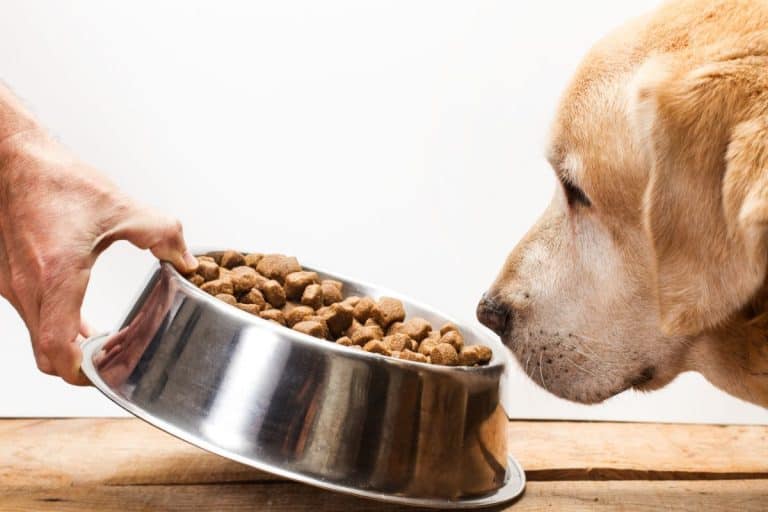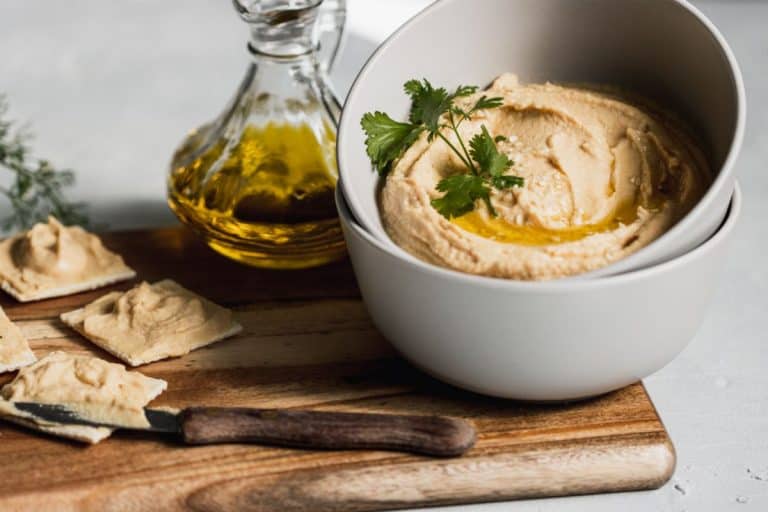How Much To Feed A Puppy By Weight – Puppy Feeding Chart
When you adopt a new puppy, it can be stressful in a lot of ways, including knowing exactly how you need to take care of your new addition.
This is especially true when it comes to knowing and understanding how much food to feed your dog.
Fortunately, you can figure out how much to feed a puppy by weight.
This means that if you know where your dog should wind up when he is done growing, you can get some reliable advice on how much food your puppy should be getting a day.
We will break down for you exactly how much to feed your puppy, based on his adult weight, what a puppy feeding chart looks like, and how often you should feed your puppy.,
We will also tell you how to help your puppy wean and even what kind of food you should be feeding your puppy.
How Much To Feed A Puppy By Weight

In order to know how much you should feed your puppy by weight, you will need to consult with a feeding chart.
The feeding chart will break down the puppy’s weight, when compared to their current age, giving you a reliable estimate of how much food you should be giving to your puppy each day.
When we say feeding by weight, we are referring to the final weight that your dog will be when he is fully grown, rather than the dog that your dog is currently at.
That way, you will be feeding more based on the nutritional needs for the size of the dog that you have.
Puppy Feeding Chart By Weight
Looking at a puppy feeding chart by weight, you will notice right away that the charts are referring to the weight as “weight at maturity” or “adult weight.”
That means that we are focusing on the estimated weight that your dog will have when he is fully grown.
You might need to consult with a growth chart in order to have that number and you should also know that it is trickier to gauge when you have a mixed breed pup.
Using the chart, you will compare the weight at maturity to the age of your puppy, in months. The amount of food that you should give your puppy is measured in cups.
If you are not sure about your dog’s breed and size, just check the growth chart again or as your vet.
Looking at a puppy feeding chart by weight, you can see a dog that weighs 3 to 12 pounds at maturity, making him a small or toy breed of dog, he will need ½ to 1 cup of food a day if he is between 6 weeks and 3 months old.
It also means that you still need to give your puppy between 4 and 6 small meals a day, so that 1 cup of food will need to be divided into equal parts throughout the day.
Looking at a puppy that is 6 months old and will weigh around 110 pounds when he is fully grown, you will see that he needs 6 1/3 cups of food a day, but will also need an additional 1/3 cup of food for every 10 pounds of weight over the 100-pound mark.
That means at if your dog will weigh 110 pounds, you know he needs 6 2/3 cups of food a day.
Remember that there might still be a range based on your dog’s caloric needs, as some breeds are higher energy than others and therefore burn more calories, whether your dog has been sterilized, and the type of food that you are giving your dog.
Some foods are higher in calorie and fat content than others and will therefore require less than leaner foods.
You may need to calculate your dog’s RER to determine what caloric intake is most appropriate for him.
Toy and small dog breeds will mature faster than large dog breeds as far as size goes, so continue to look at the chart for guidance in your dog’s growth quest.
| Weight At Maturity | 1-3 Months | 4-5 Months | 6-8 Months | 9-11 Months | 1-2 Years |
|---|---|---|---|---|---|
| 2-12 lbs | 1/2 - 1 | 2/3 - 1-1/3 | 1/2 - 1-1/2 | Feed as Adult | Feed as Adult |
| 13-20 lbs | 1/2- 1-1/4 | 1-1/8 - 2 | 3/4 - 1-1/3 | 1 - 1-1/2 | Feed as Adult |
| 21-50 lbs | 1/2 - 1-1/2 | 1-1/2 - 2-3/4 | 1-1/8 - 2-1/3 | 2 - 3 | 2 - 4-1/4 |
| 51-75 lbs | 5/8 - 2-1/3 | 1-1/2 - 4 | 1-1/2 - 3-3/4 | 2-1/2 - 4-3/4 | 2-5/8 - 6-1/4 |
| 76-99 lbs | 1 - 2-2/3 | 2-7/8 - 3-3/4 | 2-7/8 - 6-1/3 | 3-7/8 - 7 | 5-5/8 - 11 |
| 100 lbs and up | 2-2/3 cups plus and 1/3 cup for each 10 lbs of body weight over 100 lbs | 3-3/4 cups plus 1/3 cup for each 10 lbs of body weight over 100 lbs | 6-1/3 cups plus 1/3 cup for each 10 lbs of body weight over 100 lbs | 7 cups plus 1/3 cup for each 10 lbs of body weight over 100 lbs | 11 cups plus 1/3 cup for each 10 lbs of body weight over 100 lbs |
How To Bottle Feed Puppies
While it is best for a puppy to be fed directly by his mother, sometimes it isn’t possible like if the puppy was orphaned, he was separated from his mother, or perhaps his mother is not well enough to feed her puppies.
In that case, you will have to learn how to bottle feed a puppy.
To begin with, you will need to make sure that you have a milk alternative that is made specifically for puppies.
Mother’s milk is full of nutrients specific to the growth of puppies, so the next best thing is to use a formula that has been made for puppies.

With the formula, you will want to follow its instructions as far as the quantity of milk powder to water goes.
Then, you will want to make sure that the milk is as warm as body temperature. They make bottle warms for this purpose, or you can place the bottle in a hot cup of water to bring up the temperature of the milk.
After making sure the nipple of the bottle is working correctly, lay the puppy across your lap and feed him while he is on his belly.
This is a natural way that they feed. You will know that he is done when he stops swallowing the milk.
How To Wean Puppies
Whether you have been bottle-feeding your puppy or if he is getting milk from his mother, he will need to wean off of the milk in order to move onto puppy food.
This should start to happen when the puppy is around 5 weeks old.
When you begin the weaning process, you will want to use a nutrient-rich puppy food that has been softened or watered-down to make it easier to for the puppy to manage.
If the puppy is not immediately interested, you can try to get the puppy to taste the food right from your finger.
If your puppy is not immediately interested at 5 weeks, you might need to try again in a week.
There is no perfect rule on how it should be done and it will vary a lot depending on the dog himself. When he does seem interested, begin feeding him more food, more frequently until he loses interest in nursing.
Offer the puppy food 3 to 4 times a day, even while the puppy is still nursing. This is even more important with small breeds because their blood sugar will drop if they are not fed often enough. A puppy should be completely weaned by 8 weeks old.
How Often To Feed A Puppy
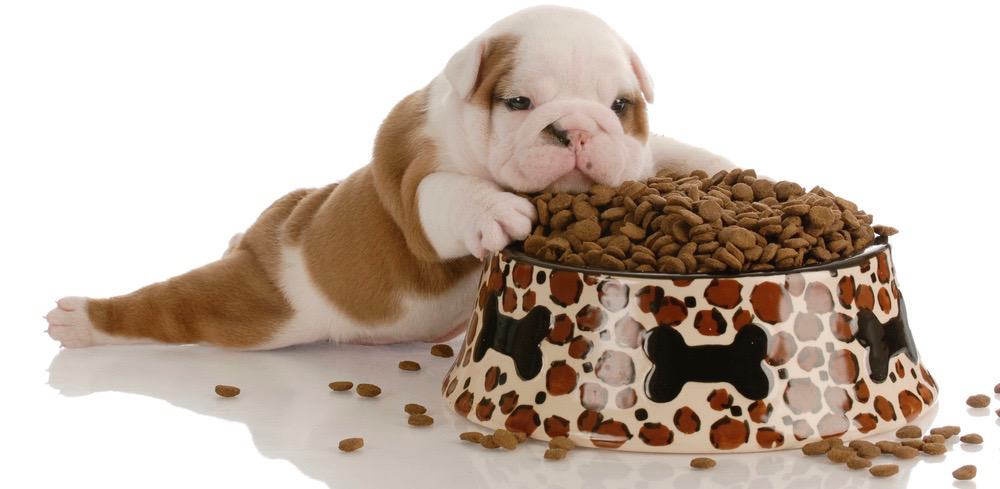
4-12 Weeks
The frequency that you need to feed your puppy will vary from 4 to 6 meals a day.
You should be able to move to 4 meals a day by the time the puppy is 8 weeks old. 4 meals will help the puppy meet his caloric daily needs as he is growing quickly and burning energy.
The quantity of food will depend entirely on the dog breed and size of the dog, but the frequency is the same.
3-12 Months
Between 3 and 12 months of age, the frequency that you are feeding the puppy will change. At between 3 and 4 months, you should be able to reduce the feeding frequency down to 3 times a day.
At 6 months, you should reduce that to just 2 meals a day. This can happen a little later if you are holding off having your dog spayed or neutered as unfixed dogs require more calories.
12+ Months
When your puppy has reached one year and older, you should be able to keep him on the two meals a day. Do not reduce your dog down to one meal a day.
It will make him ravenous while he waits for a daily meal and reduces his energy. Instead, make sure it is 2 equal meals a day. Your pup might even continue growing until he is 18 months old, so keep that in mind as well.
When To Feed A Puppy
Now that you know how often to feed your puppy, you should also know when you should feed your puppy.
Keeping your puppy on a strict feeding schedule will help with his own relationship with food and his eating habits while saving you from unnecessary headaches.
If you are feeding your puppy 3 meals a day, you should feed him somewhere around 7 am, noon, and then 5 pm.
Really, you should never feed your puppy later than 5 pm. At 5, your puppy has a chance to digest the food, and be taken outside right before bed, preventing nighttime accidents or demands to eliminate in the middle of the night.
Of course, if you are more of a night owl, feeding your puppy later might work well for you, but most puppies are early risers as they will hop out of bed with the sunrise.
Just be consistent with the timeframe to get your puppy on a schedule.
How Many Calories Do Puppies Need?
When you are considering how many calories your puppy needs a day, you should understand how to calculate your puppy’s resting energy requirement or his RER.
The RER is the amount of calories a dog’s body needs for basic organ function, like the brain and heart and it is not affected by dog breed.

You can calculate this by multiplying your dog’s body weight in kilograms to the three-fourths power by 70.
If your puppy weighs 3 pounds, he will need about 88 calories based on his RER, but if he is under 3 months of age, that number needs to be tripled.
If your puppy is over 4 months of age, the number doubles because puppies require more calories than adult dogs do.
What Nutrients Do Puppies Need?
One of the most uncommon questions that we have seen is what kind of nutrients do puppies need? Puppies and adult dogs do not have the same nutritional needs, which is why you cannot feed a puppy adult dog food.
Puppies need higher levels of carbohydrates, proteins, micronutrients, and calories in order to stay healthy.
But, a puppy’s mouth is smaller and they do not have adult teeth to work with. So not only do you want to avoid adult dog food because of the nutritional factor, you also want to avoid it to protect your puppy’s teeth.
Beyond that, you will want to be sure that the food that you have chosen is a healthy option for your puppy since not all dog foods are the same.
You will be looking at dry dog food, wet dog food, and even the option of raw dog food, so pay attention to the type.
What Food Should I Feed My Puppy
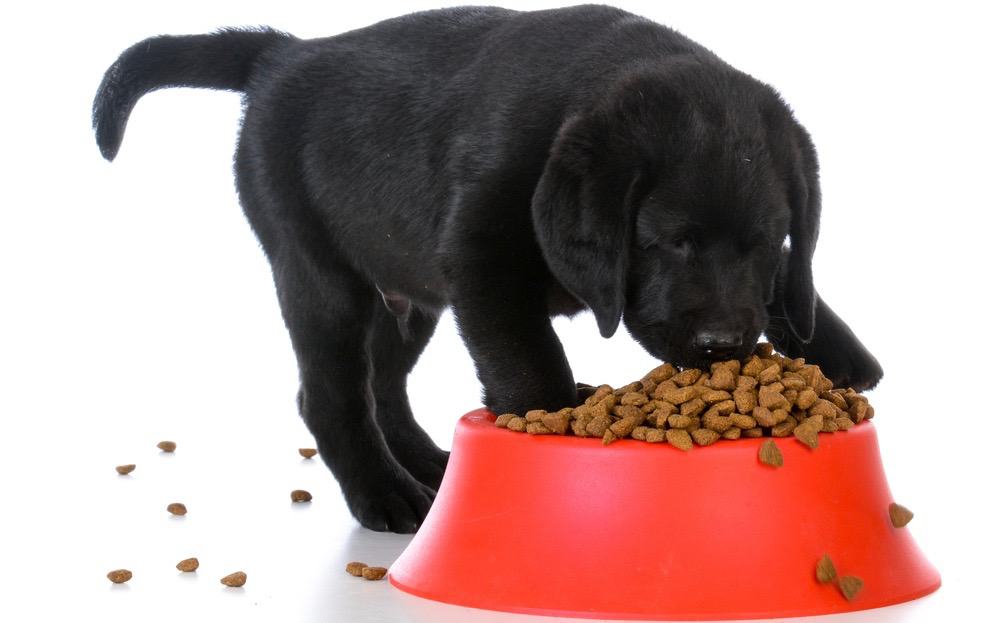
Dry Puppy Dog Food
Dry puppy dog food is without a doubt the easiest to find and the most cost-effective of the food choices for your puppy.
Dry dog food will help keep your puppy’s teeth clean as well. The only thing that you need to be careful about with dry dog food is that it is easier to pack unhealthy ingredients inside of the kibble, so you will need to really read the labels to make sure that your dog is ok with it.
If your pup is resistant to the kibble at first, you can always add a little water to soften it up and make it easier to chew.
Wet Puppy Dog Food
Wet puppy dog food has its own advantages. The taste and texture of the food are far more appealing to dogs in general.
They will typically be really excited about the idea of eating the wet puppy food. On the downside, wet foods cost a lot more than dry dog foods and are not as easily stored.
They are also higher in calories and fats, so if your puppy is looking a little overweight, you need to keep him away from the wet food. If your puppy is having trouble eating, however, wet food will save the day.
Raw Puppy Dog Food
The raw puppy dog food movement is generally controversial. It holds to the idea of feeding your dog uncooked meats and vegetables, stating this is the most natural way to eat food.
Unfortunately, it can cause illness all by itself, as the raw meat is sometimes full of bacteria or difficult to digest.
If you really would like to have raw food in your puppy’s diet, we suggest adding it to one of the meals rather than making it a primary food source. You also can buy raw dog food or follow your own recipes.
How To Transition Your Puppy To New Food
Whether you have just adopted a puppy and need to switch the food that he is one or you are weaning your puppy off of milk, there is a transition process that you need to follow to ensure that your puppy is healthy.
Switching your puppy to a different type of puppy food should happen slowly and gradually over the course of many days.
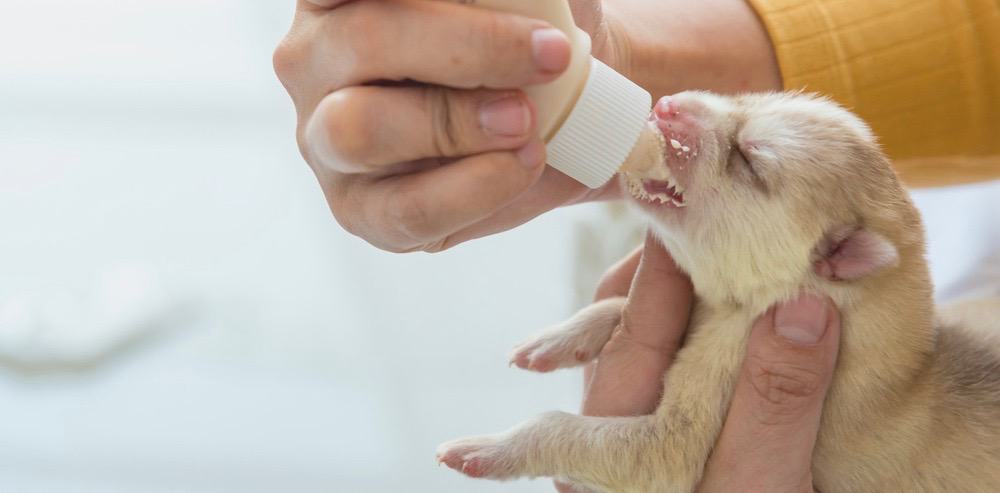
You start by mixing in the new puppy food with the current food. Only change out about 25% of it at a time. After a couple of days, make it 50% old and 50% new.
Then move on to 75% new, and finally all new. It should take one to two weeks to do well.
What To Do If Your Puppy Doesn’t Want To Eat
It can be so frustrating as a dog parent to see your puppy refusing to eat his meals. The first thing is to not panic. There are several reasons that a puppy might be refusing to eat.
- New Environment: If you have recently adopted your puppy, the new environment might be jolting and cause him to be less willing to eat.
- New Food: As your puppy transitions to a new food, he might seem apprehensive about the new food at first, but will need time to adjust.
- Picky Eater: Some dog breeds are very picky when it comes to their food. They will not starve themselves, so just keep trying.
- Illness: Of course, your puppy might be refusing to eat because he is ill. If he was a voracious eater before and suddenly stops, it is time to take him to the vet for help.
How To Switch From Puppy Food To Adult Food
When you are reading to switch your puppy from puppy food to adult food, you will follow the exact same feeding plan that we mentioned above.
You will gradually add the new food into the old one, changing the quantities to the point that there is more new food than old and then eliminating the old altogether.
Do not rush your puppy into adult food, however. The caloric and nutritional content are so important with a developing dog that you only want to switch the foods when he has reached maturity.
Can Puppies Eat Treats?
While we typically consider dog treats to be akin to junk food, puppies can have treats. Treats are a great option to help with training your puppy, but only in moderation.
Ideally, your vet should be able to supply you with some great options as far as treats go.
Generally, when shopping for dog treats, pay attention to what is inside of them and make sure that they are appropriate for your puppy.
Softer treats work better for training and make sure that they do not contain any allergens. Avoid preservatives and look for healthy ingredients like vegetables. But even with the healthiest treats, only supply them in moderation.
Final Words
In general, it might seem like there should be one obvious answer to the question “how much do I feed a puppy by his weight,” but puppy food has a lot more to it than that. You need to know what is in the food as well.
Knowing how many calories your puppy needs a day will help with knowing the type of food that he should eat and how much food that he needs.
You will also need to know his RER, which tells you the amount of calories that he needs.
Always be aware of whether your puppy is gaining or losing weight. If you can see your puppy’s ribs, he is too thin and needs more food.
If his waist vanishes after the loss of puppy weight, he might need more help. Just pay attention to your pup’s needs and he will have a long, healthy life ahead of him.



